Stroke (CJK character) on:
[Wikipedia]
[Google]
[Amazon]
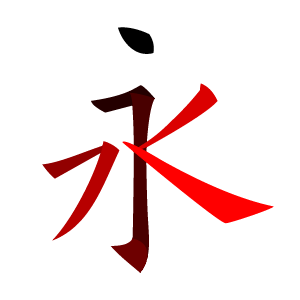 CJK strokes () are the calligraphic strokes needed to write the
CJK strokes () are the calligraphic strokes needed to write the
 (Vertical / ') is classified as a basic stroke because it is a single stroke that forms a line moving in one direction.
*
(Vertical / ') is classified as a basic stroke because it is a single stroke that forms a line moving in one direction.
* (Vertical – Horizontal – Vertical / ) is classified as a compound stroke because it is a single stroke that forms a line that includes one or more abrupt changes in direction. This example is a sequence of three basic strokes written without lifting the writing instrument such as the
(Vertical – Horizontal – Vertical / ) is classified as a compound stroke because it is a single stroke that forms a line that includes one or more abrupt changes in direction. This example is a sequence of three basic strokes written without lifting the writing instrument such as the
File:丶-order.gif
File:一-order.gif
File:丨-order.gif
File:丿-order.gif
File:亅-order.gif
File:乚-order.gif
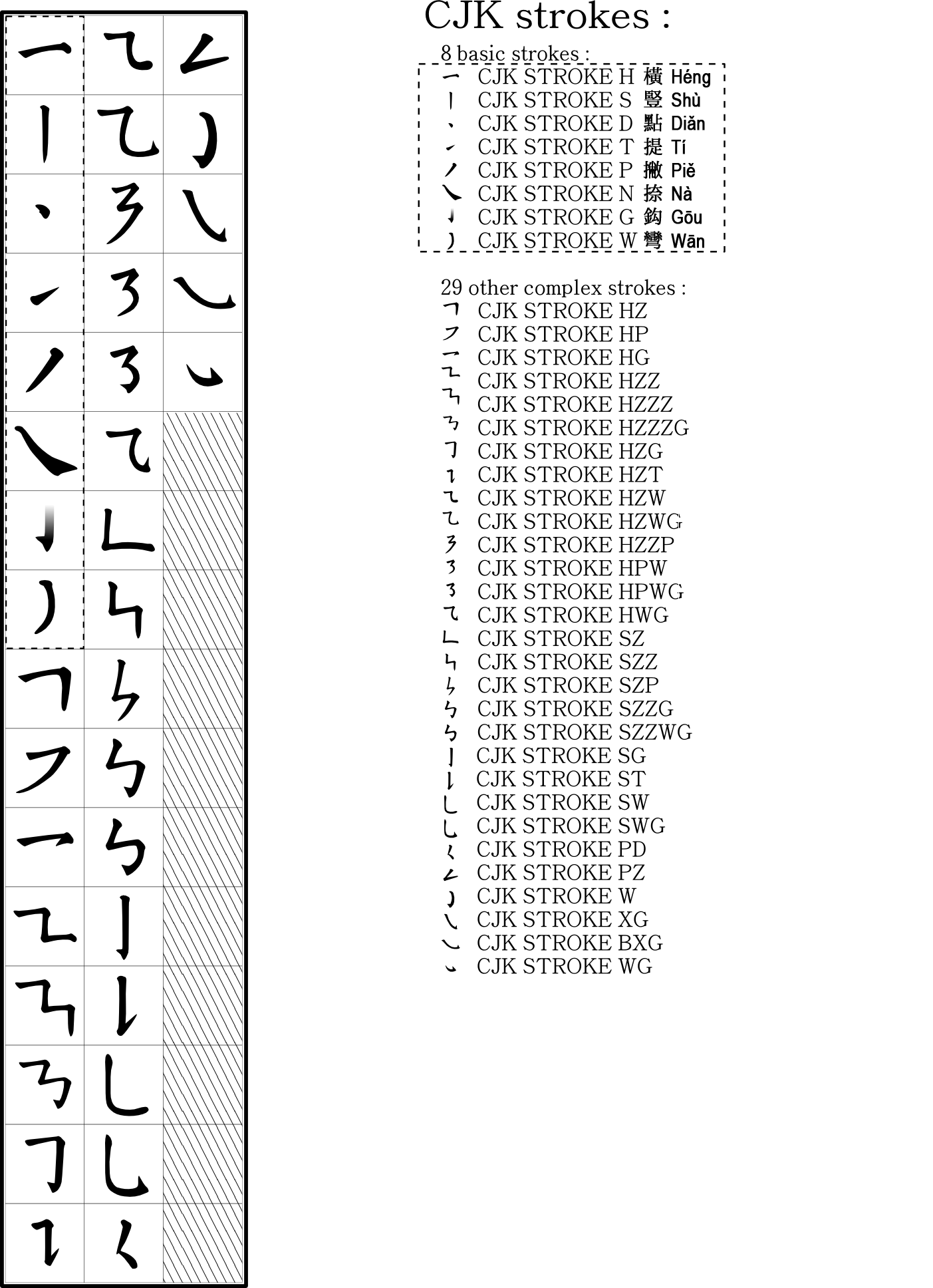 A compound stroke (also called a complex stroke) is produced when two or more basic strokes are combined in a single stroke written without lifting the writing instrument from the writing surface. The character (
A compound stroke (also called a complex stroke) is produced when two or more basic strokes are combined in a single stroke written without lifting the writing instrument from the writing surface. The character ( (Vertical – J hook / ''Shù Gōu''). A stroke naming convention sums the names of the basic strokes, in the writing order.
An exception to this applies when a stroke makes a turn of 90° (and only of 90°) in the
(Vertical – J hook / ''Shù Gōu''). A stroke naming convention sums the names of the basic strokes, in the writing order.
An exception to this applies when a stroke makes a turn of 90° (and only of 90°) in the  (''Héng'') and Vertical
(''Héng'') and Vertical  (Shù) strokes are identified only once when they appear as the first stroke of a compound; any single stroke with successive 90° turns down or to the right are indicated by a Zag 折 (
(Shù) strokes are identified only once when they appear as the first stroke of a compound; any single stroke with successive 90° turns down or to the right are indicated by a Zag 折 ( (''Shù Zhé''). In the same way, an initial ''Shù'' followed by an abrupt turn right followed by a second turn down produces
(''Shù Zhé''). In the same way, an initial ''Shù'' followed by an abrupt turn right followed by a second turn down produces  (''Shù Zhé Zhé''). However, their inherited names are "Vertical – Horizontal" and "Vertical – Horizontal – Vertical". We need not to use "Zag" in the inherited names.
Nearly all complex strokes can be named using this simple scheme.
(''Shù Zhé Zhé''). However, their inherited names are "Vertical – Horizontal" and "Vertical – Horizontal – Vertical". We need not to use "Zag" in the inherited names.
Nearly all complex strokes can be named using this simple scheme.
 named 横 (pinyin: ''Héng''); in a compound example, HZT represents 横折提 (pinyin: ''Héng Zhé Tí'').
While no consensus exists, there are up to 12 distinct basic strokes that are identified by a unique Han radical.
There are many CJK compound strokes, however there is no consensus for sequence letter naming of compound strokes using the basic strokes. The following table demonstrates the CJK stroke naming convention:
Besides, some strokes have been unified or abandoned in Unicode:
Note that some names in the list do not follow the rules of controlled vocabulary. For example, stroke P (''Piě)'' is not found in the compound stroke PN. The name "PN" comes from 平捺 (pinyin: ''Píng Nà''), not 撇捺 (pinyin: ''Piě Nà''). The meaning of 平 (pinyin: ''Píng'') is "flat", and it should be called "BN" 扁捺 (pinyin: Biǎn Nà) if the rules are to be followed closely. The letter "Z" in stroke SWZ means 左 (pinyin: ''Zuǒ''), not 折 (pinyin: ''Zhé''). The meaning of 左 is "left", and it is not defined in the naming convention. Moreover, some 折 (pinyin: ''Zhé'') strokes are far more than or far less than 90°, such as stroke HZZZG, stroke HZZP and stroke PZ.
Some strokes are not included in the Unicode standard, such as
named 横 (pinyin: ''Héng''); in a compound example, HZT represents 横折提 (pinyin: ''Héng Zhé Tí'').
While no consensus exists, there are up to 12 distinct basic strokes that are identified by a unique Han radical.
There are many CJK compound strokes, however there is no consensus for sequence letter naming of compound strokes using the basic strokes. The following table demonstrates the CJK stroke naming convention:
Besides, some strokes have been unified or abandoned in Unicode:
Note that some names in the list do not follow the rules of controlled vocabulary. For example, stroke P (''Piě)'' is not found in the compound stroke PN. The name "PN" comes from 平捺 (pinyin: ''Píng Nà''), not 撇捺 (pinyin: ''Piě Nà''). The meaning of 平 (pinyin: ''Píng'') is "flat", and it should be called "BN" 扁捺 (pinyin: Biǎn Nà) if the rules are to be followed closely. The letter "Z" in stroke SWZ means 左 (pinyin: ''Zuǒ''), not 折 (pinyin: ''Zhé''). The meaning of 左 is "left", and it is not defined in the naming convention. Moreover, some 折 (pinyin: ''Zhé'') strokes are far more than or far less than 90°, such as stroke HZZZG, stroke HZZP and stroke PZ.
Some strokes are not included in the Unicode standard, such as  ,
,  ,
,  ,
,  ,
,  ,
,  , etc.
In Simplified Chinese, stroke TN
, etc.
In Simplified Chinese, stroke TN  is usually written as
is usually written as  (It was called "stroke DN", but Unicode has rejected it).
(It was called "stroke DN", but Unicode has rejected it).
 ,
,  ,
,  ,
,  ,
,  ,
,  ,
,  ,
,  , etc.
Besides, there are ways of grouping strokes that are different from the Unicode standard. For example, stroke
, etc.
Besides, there are ways of grouping strokes that are different from the Unicode standard. For example, stroke  is merged into stroke
is merged into stroke  in Unicode system, while it is merged into
in Unicode system, while it is merged into  in this numbering scheme.
in this numbering scheme.
 ;Eight basic strokes
The extended CJK(V) set of strokes has 29 strokes. These most common 29 used strokes can be reduced to combinations of 8 basic strokes, for a total of 37 strokes. The subset of 8 is found in the character "eternity" 永, hence the name of this set. But other sets of CJK(V) strokes can be found.
:
;Eight basic strokes
The extended CJK(V) set of strokes has 29 strokes. These most common 29 used strokes can be reduced to combinations of 8 basic strokes, for a total of 37 strokes. The subset of 8 is found in the character "eternity" 永, hence the name of this set. But other sets of CJK(V) strokes can be found.
: - the ''Diǎn'' 點 / 点, is a dot, filled from the top, to the bottom, traditionally made by "couching" the brush on the page.
:
- the ''Diǎn'' 點 / 点, is a dot, filled from the top, to the bottom, traditionally made by "couching" the brush on the page.
: - the ''Héng'' 横, is horizontal, filled from left to right, the same way the Latin letters A, B, C, D are written.
:
- the ''Héng'' 横, is horizontal, filled from left to right, the same way the Latin letters A, B, C, D are written.
: - the ''Shù'' 豎 / 竖, is vertical-falling. The brush begins by a dot on top, then falls downward.
:
- the ''Shù'' 豎 / 竖, is vertical-falling. The brush begins by a dot on top, then falls downward.
: - the ''Gōu'' 鈎(鉤) / 钩, ending another stroke, is a sharp change of direction either down (after a Heng) or left (after a Shù).
:
- the ''Gōu'' 鈎(鉤) / 钩, ending another stroke, is a sharp change of direction either down (after a Heng) or left (after a Shù).
: - the ''Tí'' 提 / ''Tiāo'' 提, is a flick up and rightwards.
:
- the ''Tí'' 提 / ''Tiāo'' 提, is a flick up and rightwards.
: - the ''Wān'' 彎 / 弯, follows a concave path on the left or on the right.
:
- the ''Wān'' 彎 / 弯, follows a concave path on the left or on the right.
: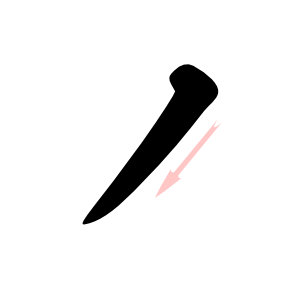 - the ''Piě'' 撇, is a falling leftwards (with a slight curve).
:
- the ''Piě'' 撇, is a falling leftwards (with a slight curve).
: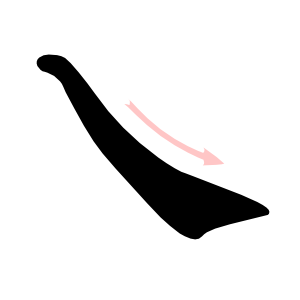 - the ''Nà'' 捺, is falling rightwards (with an emphasis at the end of the stroke).
:(+
- the ''Nà'' 捺, is falling rightwards (with an emphasis at the end of the stroke).
:(+ 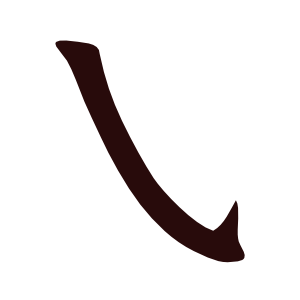 - the ''Xié'' 斜 is sometimes added to the 永's strokes. It's a concave ''Shù'' falling right, always ended by a ''Gōu'').
- the ''Xié'' 斜 is sometimes added to the 永's strokes. It's a concave ''Shù'' falling right, always ended by a ''Gōu'').
Unicode: CJK Strokes, Range: 31C0–31EF
— set of 36 CJK strokes
The Unicode Standard Core Specification: Appendix F - Documentation of CJK Strokes
Proposal to add twenty strokes to Unicode
this proposal has been approved and is at Stage 6 of th
as of July 30, 2007.
Standardization documents of Inherited Glyphs: List of Strokes for Inherited Glyphs
Ministry of Education, R.O.C.: Grouping list of CJK Strokes
State Language Commission, P.R.C.: Chinese Character Component Standard of GB 13000.1 Character Set for Information Processing
State Language Commission, P.R.C.: Chinese Character Turning Stroke Standard of GB 13000.1 Character Set
38 CJK strokes, by Wenlin Institute
Tom Bishop, Richard Cook: Character Description Language (CDL): The Set of Basic CJK Unified Stroke Types
Yannis Haralambous: Seeking Meaning in a Space Made out of Strokes, Radicals, Characters and Compounds
Yannis Haralambous: Fonts & Encodings
O'Reilly Media Inc., Sept 26 2007, p. 154-156 {{DEFAULTSORT:Stroke (Cjk Character) Chinese characters East Asian calligraphy Hanja Kana Kanji Unicode
 CJK strokes () are the calligraphic strokes needed to write the
CJK strokes () are the calligraphic strokes needed to write the Chinese characters
Chinese characters () are logograms developed for the writing of Chinese. In addition, they have been adapted to write other East Asian languages, and remain a key component of the Japanese writing system where they are known as ''kanji ...
in regular script
Regular script (; Hepburn: ''kaisho''), also called (), (''zhēnshū''), (''kǎitǐ'') and (''zhèngshū''), is the newest of the Chinese script styles (popularized from the Cao Wei dynasty c. 200 AD and maturing stylistically around th ...
used in East Asian calligraphy. CJK strokes are the classified set of line patterns that may be arranged and combined to form Chinese characters (also known as Hanzi
Chinese characters () are logograms developed for the writing of Chinese. In addition, they have been adapted to write other East Asian languages, and remain a key component of the Japanese writing system where they are known as ''kanji' ...
) in use in China, Japan, and Korea.
Purpose
The study and classification of CJK strokes is used for: #understanding Chinese character calligraphy – the correct method of writing, shape formation and stroke order required for character legibility; #understanding stroke changes according to the style that is in use; #defining stroke naming and counting conventions; #identifying fundamental components of Han radicals; and #their use in computing.Formation
When writing Han radicals, a single stroke includes all the motions necessary to produce a given part of a character before lifting the writing instrument from the writing surface; thus, a single stroke may have abrupt changes in direction within the line. For example: *ink brush
Ink is a gel, sol, or solution that contains at least one colorant, such as a dye or pigment, and is used to color a surface to produce an image, text, or design. Ink is used for drawing or writing with a pen, brush, reed pen, or quill. ...
from the writing surface.
Direction
All strokes have direction. They are unidirectional and start from one entry point. As such, they are usually not written in the reverse direction by native users. Here are some examples:Types
CJK strokes are an attempt to identify and classify all single-stroke components that can be used to write Han radicals. There are some thirty distinct types of strokes recognized inChinese character
Chinese characters () are logograms developed for the writing of Chinese. In addition, they have been adapted to write other East Asian languages, and remain a key component of the Japanese writing system where they are known as ''kanji' ...
s, some of which are compound strokes made from basic strokes. The compound strokes comprise more than one movement of the writing instrument, and many of these have no agreed-upon name.
Basic strokes
A basic stroke is a single calligraphic mark moving in one direction across a writing surface. The following table lists a selection of basic strokes divided into two stroke groups: simple and combining. "Simple strokes" (such as Horizontal / ''Héng'' and Dot / ''Diǎn'') can be written alone. "Combining strokes" (such as Zig / ''Zhé'' and J hook / ''Gōu'') never occur alone, but must be paired with at least one other stroke forming a compound stroke. Thus, they are not in themselves individual strokes. Note, the basic stroke ''Diǎn'' "Dot" is rarely a real dot. Instead it usually takes the shape of a very small line pointing in one of several directions, and may be long enough to be confused with other strokes.Compound strokes
 A compound stroke (also called a complex stroke) is produced when two or more basic strokes are combined in a single stroke written without lifting the writing instrument from the writing surface. The character (
A compound stroke (also called a complex stroke) is produced when two or more basic strokes are combined in a single stroke written without lifting the writing instrument from the writing surface. The character (pinyin
Hanyu Pinyin (), often shortened to just pinyin, is the official romanization system for Standard Mandarin Chinese in China, and to some extent, in Singapore and Malaysia. It is often used to teach Mandarin, normally written in Chinese fo ...
: ) "eternity" described in more detail below demonstrates one of these compound strokes. The centre line is a compound stroke that combines three stroke shapes in a single stroke.
;Basics for making compound strokes
In most cases, concatenating basic strokes together form a compound stroke. For example, Vertical / ''Shù'' combined with J hook / ''Gōu'' produce Simplified Chinese
Simplification, Simplify, or Simplified may refer to:
Mathematics
Simplification is the process of replacing a mathematical expression by an equivalent one, that is simpler (usually shorter), for example
* Simplification of algebraic expressions ...
names. Horizontal pinyin
Hanyu Pinyin (), often shortened to just pinyin, is the official romanization system for Standard Mandarin Chinese in China, and to some extent, in Singapore and Malaysia. It is often used to teach Mandarin, normally written in Chinese fo ...
: ''Zhé'') "Break". For example, an initial ''Shù'' followed by an abrupt turn right produces Nomenclature
Organization systems used to describe and differentiate strokes may include the use of roman letters, Chinese characters, numbers, or a combination of these devices. Two methods of organizing CJK strokes are by: # Classification schemes that describe strokes by a naming convention or by conformity to ataxonomy
Taxonomy is the practice and science of categorization or classification.
A taxonomy (or taxonomical classification) is a scheme of classification, especially a hierarchical classification, in which things are organized into groups or types. ...
; and
# Categorization schemes that differentiate strokes by numeric or topical grouping.
In classification schemes, stroke forms are described, assigned a representative character or letterform, and may be arranged in a hierarchy. In categorization schemes, stroke forms are differentiated, sorted and grouped into like categories; categories may be topical, or assigned by a numeric or alpha-numeric nominal number according to a designed numbering scheme
There are many different numbering schemes for assigning nominal numbers to entities. These generally require an agreed set of rules, or a central coordinator. The schemes can be considered to be examples of a primary key of a database management s ...
.
;Benefits
Organizing strokes into a hierarchy aids a user's understanding by bringing order to an obtuse system of writing that has organically evolved
Evolution is change in the heritable characteristics of biological populations over successive generations. These characteristics are the expressions of genes, which are passed on from parent to offspring during reproduction. Variati ...
over the period of centuries. In addition, the process of recognizing and describing stroke patterns promotes consistency of stroke formation and usage. When organized by naming convention, classification allows a user to find a stroke quickly in a large stroke collection, makes it easier to detect duplication, and conveys meaning when comparing relationships between strokes. When organized by numbering scheme, categorization aids a user in understanding stroke differences, and makes it easier to make predictions, inferences and decisions about a stroke.
;Limitations
Strokes are described and differentiated using the criteria of visual qualities of a stroke. Because this can require subjective interpretation, CJK strokes cannot be placed into a single definitive classification scheme because stroke types lack a universal consensus on the description and number of basic and compound forms. CJK strokes cannot be placed into a single definitive categorization scheme due to visual ambiguity between strokes, and therefore cannot be segregated into mutually exclusive groups. Other factors inhibiting organization based on visual criteria are the variation of writing styles, and the changes of appearance that a stroke undergoes within various characters.
Roman letter naming convention of Unicode standard
A naming convention is a classification scheme where acontrolled vocabulary
Control may refer to:
Basic meanings Economics and business
* Control (management), an element of management
* Control, an element of management accounting
* Comptroller (or controller), a senior financial officer in an organization
* Control ...
is used systematically to describe the characteristics of an item. The naming convention for a CJK stroke is derived from the path mark left by the writing instrument. In this instance roman letters are concatenated to form a stroke name as a sequence of one or more roman letters indicating the component strokes used to create the CJK stroke. The first letter of the Han radical’s pinyin pronunciation represents each basic stroke. In a basic stroke example, H represents the stroke Abbreviated naming conventions
On the other hand, naming conventions that use abbreviated forms of the CJK strokes also exist. After the names of CJK strokes are translated into English, first letters of the English names are used in the naming system. The controlled vocabulary can be divided into two groups. The first group is the abbreviated forms of the basic strokes. The second group is the abbreviated forms of deformations. “Zig” can be omitted in the naming system. The following table demonstrates the CJK stroke naming convention:Numbering scheme
A numbering scheme is a categorisation method where similar strokes are grouped into categories labeled by nominal numbers. Category numbering may be an index of numbers of types, with sub-types indicated by a decimal point followed by another number or a letter. The following table is a common numbering scheme that uses similar names as the Roman letter naming convention, but the stroke forms are grouped into major category types (1 to 5), which further break down into 25 sub-types in category 5. Some strokes are not included in the numbering scheme, such as strokeStroke order
Stroke order refers to the order in which the strokes of a Chinese character are written. A stroke is a movement of a writing instrument on a writing surface. Certain stroke orders guidelines are recommended to ensure speed, accuracy, and legibility in composition, as mostChinese characters
Chinese characters () are logograms developed for the writing of Chinese. In addition, they have been adapted to write other East Asian languages, and remain a key component of the Japanese writing system where they are known as ''kanji ...
have many strokes. As such, teachers enforce exactly one stroke order for each character, marking every deviation as a mistake, so everyone writes these characters the same way. The stroke order follows a few simple rules, though, which aids in memorizing these. To write CJK characters, one must know how to write CJK strokes, and thus, needs to identify the basic strokes that make up a character.
Eight Principles of Yong
The Eight Principles of ''Yong'' explain how to write eight commonstroke
A stroke is a disease, medical condition in which poor cerebral circulation, blood flow to the brain causes cell death. There are two main types of stroke: brain ischemia, ischemic, due to lack of blood flow, and intracranial hemorrhage, hemorr ...
s in regular script
Regular script (; Hepburn: ''kaisho''), also called (), (''zhēnshū''), (''kǎitǐ'') and (''zhèngshū''), is the newest of the Chinese script styles (popularized from the Cao Wei dynasty c. 200 AD and maturing stylistically around th ...
which are found all in one character, (, "forever", "permanence"). It was traditionally believed that the frequent practice of these principles as a beginning calligrapher could ensure beauty in one's writing.
 - the ''Diǎn'' 點 / 点, is a dot, filled from the top, to the bottom, traditionally made by "couching" the brush on the page.
:
- the ''Diǎn'' 點 / 点, is a dot, filled from the top, to the bottom, traditionally made by "couching" the brush on the page.
: - the ''Héng'' 横, is horizontal, filled from left to right, the same way the Latin letters A, B, C, D are written.
:
- the ''Héng'' 横, is horizontal, filled from left to right, the same way the Latin letters A, B, C, D are written.
: - the ''Shù'' 豎 / 竖, is vertical-falling. The brush begins by a dot on top, then falls downward.
:
- the ''Shù'' 豎 / 竖, is vertical-falling. The brush begins by a dot on top, then falls downward.
: - the ''Gōu'' 鈎(鉤) / 钩, ending another stroke, is a sharp change of direction either down (after a Heng) or left (after a Shù).
:
- the ''Gōu'' 鈎(鉤) / 钩, ending another stroke, is a sharp change of direction either down (after a Heng) or left (after a Shù).
: - the ''Tí'' 提 / ''Tiāo'' 提, is a flick up and rightwards.
:
- the ''Tí'' 提 / ''Tiāo'' 提, is a flick up and rightwards.
: - the ''Wān'' 彎 / 弯, follows a concave path on the left or on the right.
:
- the ''Wān'' 彎 / 弯, follows a concave path on the left or on the right.
: - the ''Piě'' 撇, is a falling leftwards (with a slight curve).
:
- the ''Piě'' 撇, is a falling leftwards (with a slight curve).
: - the ''Nà'' 捺, is falling rightwards (with an emphasis at the end of the stroke).
:(+
- the ''Nà'' 捺, is falling rightwards (with an emphasis at the end of the stroke).
:(+  - the ''Xié'' 斜 is sometimes added to the 永's strokes. It's a concave ''Shù'' falling right, always ended by a ''Gōu'').
- the ''Xié'' 斜 is sometimes added to the 永's strokes. It's a concave ''Shù'' falling right, always ended by a ''Gōu'').
Use in computing
The stroke count method is based on the order of strokes to input characters on Chinese mobile phones. As part ofChinese character encoding
In computing, Chinese character encodings can be used to represent text written in the CJK languages— Chinese, Japanese, Korean—and (rarely) obsolete Vietnamese, all of which use Chinese characters. Several general-purpose characte ...
, there have been several proposals to encode the CJK strokes, most of time with a total around 35~40 entries. Most notable is the current Unicode
Unicode, formally The Unicode Standard,The formal version reference is is an information technology standard for the consistent encoding, representation, and handling of text expressed in most of the world's writing systems. The standard, ...
block “CJK Strokes” (U+31C0..U+31EF), with 36 types of strokes:
See also
* Chinese characters description languagesReferences
External links
Unicode: CJK Strokes, Range: 31C0–31EF
— set of 36 CJK strokes
The Unicode Standard Core Specification: Appendix F - Documentation of CJK Strokes
Proposal to add twenty strokes to Unicode
this proposal has been approved and is at Stage 6 of th
as of July 30, 2007.
Standardization documents of Inherited Glyphs: List of Strokes for Inherited Glyphs
Ministry of Education, R.O.C.: Grouping list of CJK Strokes
State Language Commission, P.R.C.: Chinese Character Component Standard of GB 13000.1 Character Set for Information Processing
State Language Commission, P.R.C.: Chinese Character Turning Stroke Standard of GB 13000.1 Character Set
38 CJK strokes, by Wenlin Institute
Tom Bishop, Richard Cook: Character Description Language (CDL): The Set of Basic CJK Unified Stroke Types
Yannis Haralambous: Seeking Meaning in a Space Made out of Strokes, Radicals, Characters and Compounds
Yannis Haralambous: Fonts & Encodings
O'Reilly Media Inc., Sept 26 2007, p. 154-156 {{DEFAULTSORT:Stroke (Cjk Character) Chinese characters East Asian calligraphy Hanja Kana Kanji Unicode